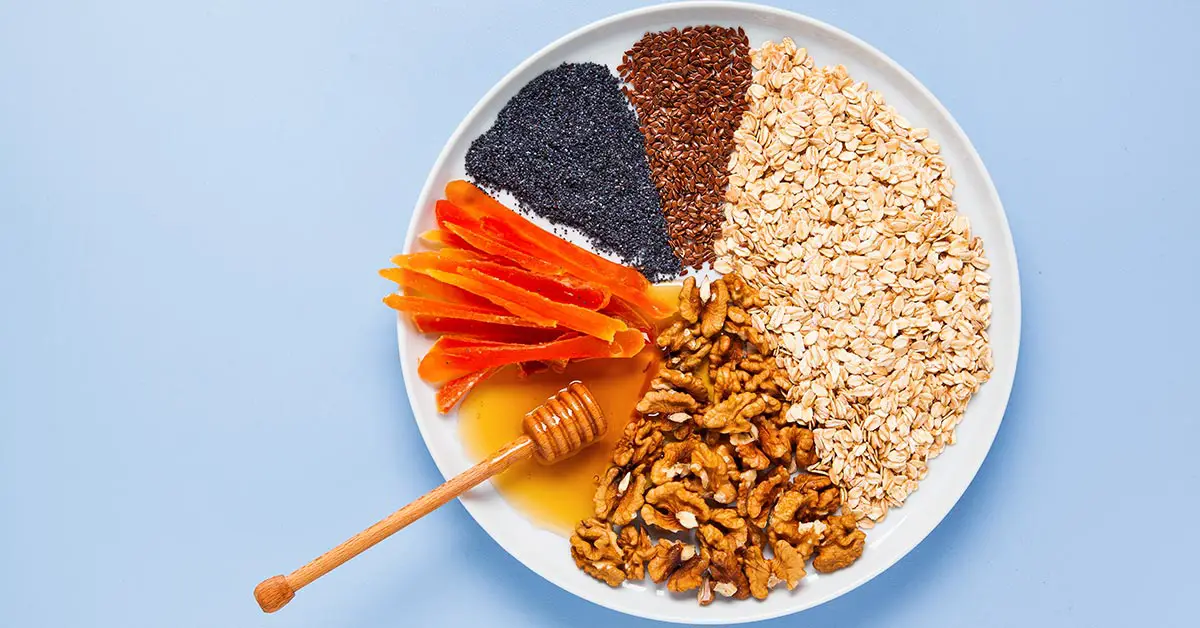In today’s society, it can be difficult to have a healthy relationship with food. We live in a world of extremes. On one hand, you have extreme diet restrictions, on another, there are hot dog eating contests and “freak shakes”. We’re bombarded with messages from brands, ads, “influencers”, and other forms of media telling us to eat this and not that; that these foods are okay but these will most definitely make us fat and/or give us diseases. It’s confusing and leads to a lot of shame and fear surrounding our daily food choices.
If you’re feeling overwhelmed, you’re not alone. Thankfully, these handy food charts will break everything down for you in a simple way. No stress, no fear, and no shaming – just food and facts.
40 Food Charts To Change The Way You See Your Food
You’ve already got enough to worry about in your day – your job, your family, your friends, and more. Why add the stress of feeling bad or afraid about what foods you are choosing to eat every day on top of it? After all, food really is not just there to keep us alive and thriving, but also for enjoyment, togetherness, tradition, and so much more. So rather than allowing supposedly “good” versus “bad” foods to stress you out, have a look at these food charts by Graem Tomlinson, known on Instagram as The Fitness Chef. They simplify things and will hopefully make you feel more confident and less ashamed of what you choose to eat each day.
1. Portion Sizes Matter

Proper portion sizes are often people’s biggest downfall when they are trying to eat a healthier diet or lose weight. It’s not so much what they’re eating, it’s how much. For example, in this case, melted cheese on toast offers protein, calcium, fiber, and more. Too much cheese, however, gives this snack meal-worthy calorie levels. Keep portion sizes in mind, especially when it comes to denser foods such as cheese, and you will find yourself a lot better off.
2. High Protein Marketing Gimmic

Marketing basically relies on the fact that most people won’t read labels or actually compare one item to another, kind of like this food chart above. This means that they will boast how much protein is in various products – and charge you a lot more for them – when the difference is negligible if it exists at all.
“As one can gather from this list of similar foods, a product that boasts of its protein content may not necessarily contain more protein per weight than a product bereft of marketing, but similar or greater in protein content.” Tomlinson writes on Instagram.
3. More Than Meets The Eye

That’s the key right there at the bottom: Each food we eat offers us something different. Yes, avocado toast using brown bread offers plenty of nutrients and also can be quite enjoyable. While Nutella on white bread may not have too much in terms of nutrient value, it can still be enjoyed as a part of a healthy diet. The idea is to stick with your goals and eating a variety of foods to meet those needs.
“in this example, consumption of the former [avocado toast] means enjoyment, more nutrients and fibre, but also more calories. Whereas consumption of the latter [Nutella toast] means enjoyment, less nutrients and fibre, but in this example, significantly fewer calories.“
4. Ruined vs. Quick Results
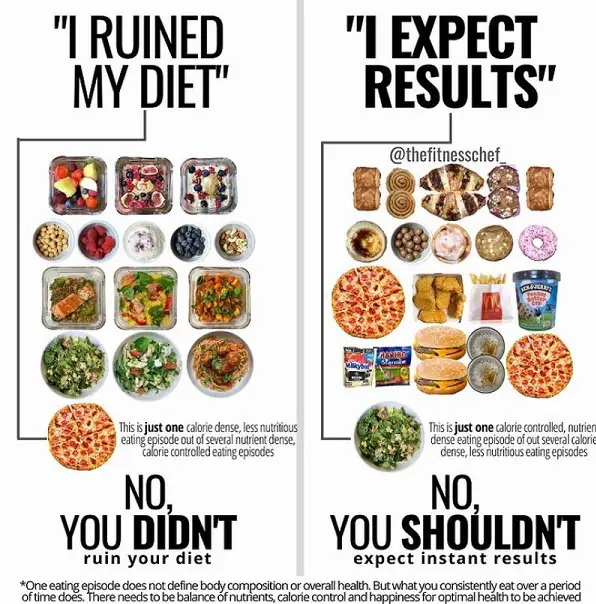
“When all is said and done, the things we do consistently shape the outcomes in our existence. And the things we do sporadically don’t hold as much significance.“
Eating one less healthy meal every once in a while is not going to drastically affect your health or change your body. On the same token, eating one nutrient-dense healthy meal is also not going to have the positive effect you want if you only eat it once in a while. The key is consistency while still allowing yourself to enjoy some of your favorite foods on occasion.
5. Sweet Potatoes vs. Regular Potatoes

Since when did regular white potatoes become “bad” for you? The last time I checked, they were a nutrient-dense vegetable that grows from the ground. Somehow along the way when colorful foods were being praised more and more, the regular white potato lost its footing. Take this as a friendly reminder that every food has its own benefits and, especially when comparing two root vegetables, one is not better than the other. While the above food chart focuses mostly on calories, when it comes to micronutrients both potatoes and sweet potatoes can be very healthy!
6. Daily Habits Add Up

It is perfectly okay to treat ourselves every once in a while. If your goal is to be healthier or lose weight, however, you do need to think a bit more about when you’re consuming and how often. Take a look at this food chart above, as you can see on the right side of the photo, this day of eating still has some tasty treats in there. The difference is that they are spread out throughout the idea as opposed to all being dumped into one meal. They are also small treats that fit within a plan, rather than a splurge where you will still need to eat two or three more times on top of it that day.
7. Mindset
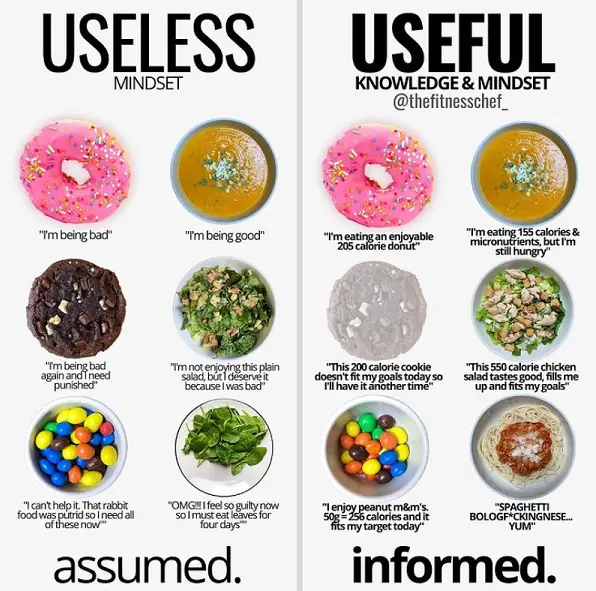
Viewing each time we eat as either “good” or “bad” doesn’t actually do anything to help us. At the end of the day, it just makes our lives more stressful and less enjoyable. Educating ourselves so that we can make informed, healthy, and guilt-free decisions makes each eating experience better. Take a look at this food chart above, it has some great insight.
“Viewing eating experiences as good and bad is useless if we want to understand what consumption truly means for us. And whilst the ‘good/bad’ mindset appears like it may only impact isolated food choices here and there, it actually impacts the next food choice. And the next… and so on“
8. Stop The Comparisons
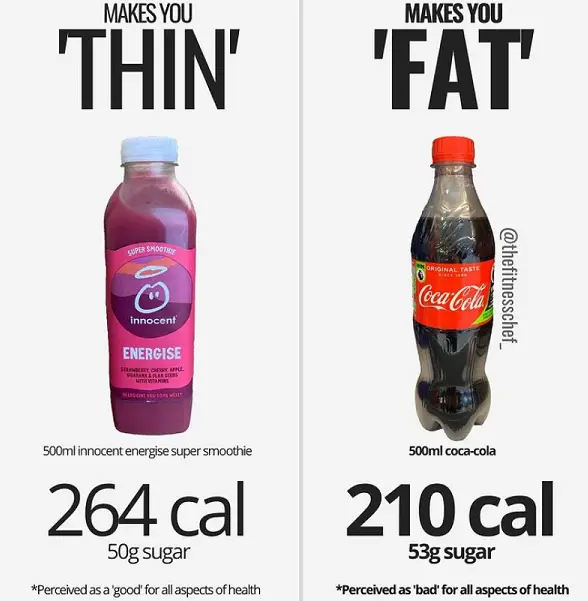
Yes, again, the beverage on the left has a higher nutrient value than the one on the right. That being said, they are actually quite comparable in both calories and sugar. Some argue that one has “naturally occurring” sugars while the other no, however, I am here to tell you that your body doesn’t care. To your body, sugar is sugar and calories are calories. It doesn’t mean you should necessarily be swapping your smoothie for a coke on the regular. Rather, this is for you to realize that your smoothie isn’t the health home-run that you necessarily think it is.
9. Healthy Snacking
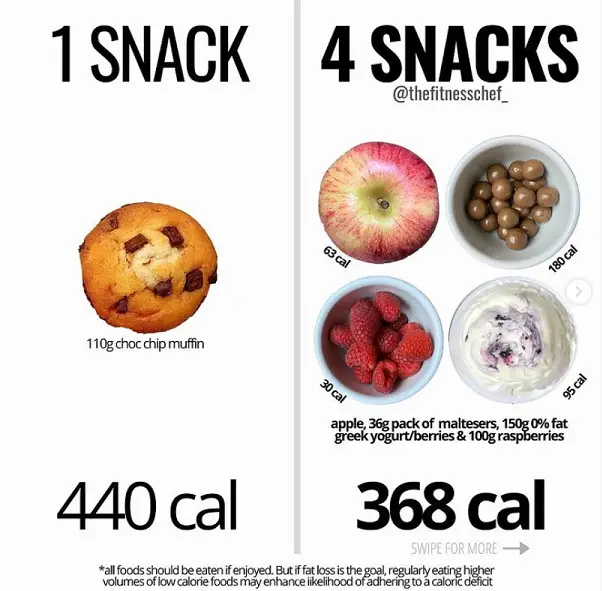
It is okay to treat ourselves to things like chocolate chip muffins or cinnamon buns every once in a while. On a regular basis, however, if your goal is a healthier, leaner body, then you do need to be mindful of how you are snacking. The goal with snacks should always be something that satisfies your hunger, makes you happy eating it, and offers some sort of nutrition along with it. Take a look at the food chart above, and ask yourself, which side looks more satisfying?
Read: Blue Java Banana: The Banana That Tastes ‘Just Like Vanilla Ice Cream
10. A Coffee Break
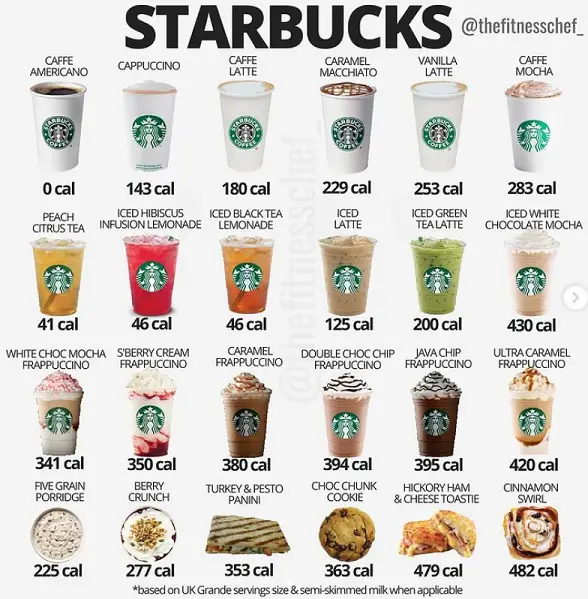
We often don’t even really consider our innocent coffee break in our daily food intake. This is especially true when considering the beverages we drink. Unfortunately, that coffee is likely packing a bigger calorie punch than you think. Many of the coffee drinks we enjoy regularly really should be considered as a dessert more than a mid-day pick-up. Drink one on the odd occasion? Totally fine. Once (or even twice) per day? Not as innocent as it seems.
11. Bread Is Not Bad
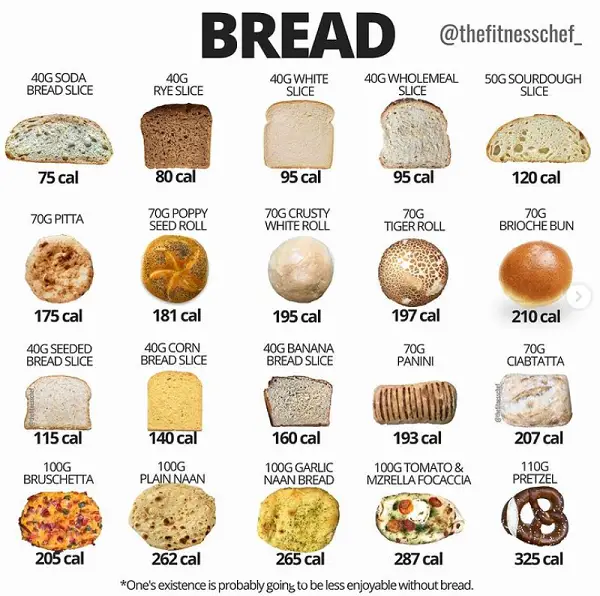
Unless you have Celiac Disease or some other kind of gluten intolerance then no, bread is not the devil and is not making you fat. Bread is and can be a part of a healthy diet. This doesn’t just mean whole grain brown bread – this means all kinds of bread. This food chart takes focuses on calories, which can be taken into consideration along with other important aspects of nutrition, like vitamins, minerals, and fiber.
“If you enjoy bread, include it in your diet. If you don’t enjoy bread, don’t include it. But whatever your decision, make it in the knowledge that any food can be enjoyed as part of a balanced diet.“
12. Stop Food Shaming
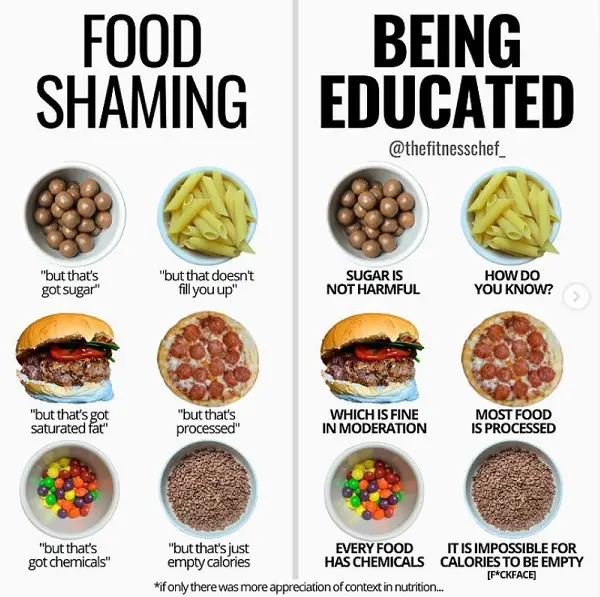
Whether they realize they are doing it or not, people (or yourself) will food shame others. It is not entirely anyone’s fault, either. We’ve been fed plenty of false information that has made us fear certain kinds of foods. We receive confusing and conflicting messages about food daily. On top of it, we’ve grown up in a fat-phobic culture that praises very few body types. Check your (usually false) food beliefs and don’t let others shame you for what you are eating.
13. Mind Your Condiments
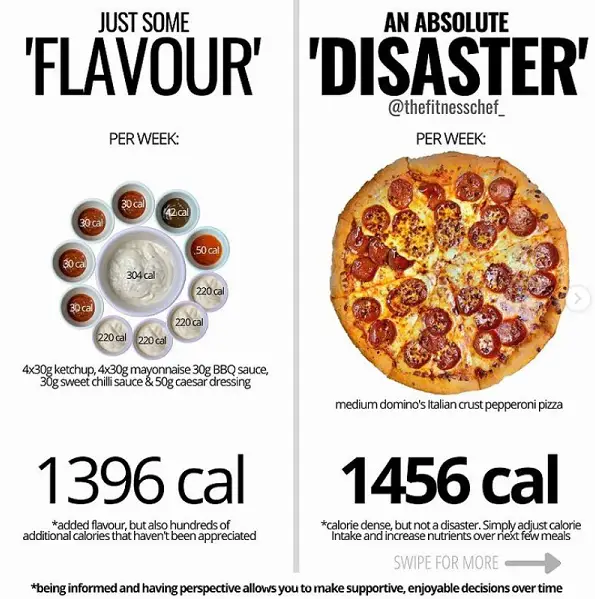
We often look at something like a pizza as one big calorie bomb. The little things, however, really do add up. Be mindful of the sauces and condiments you are using and how much of them you are using. While these may seem like innocent flavor additions, they add up over time. Again, moderation is key and making sure what you’re consuming is in line with your goals.
14. “Good” vs “Bad” Breakfast Cereals
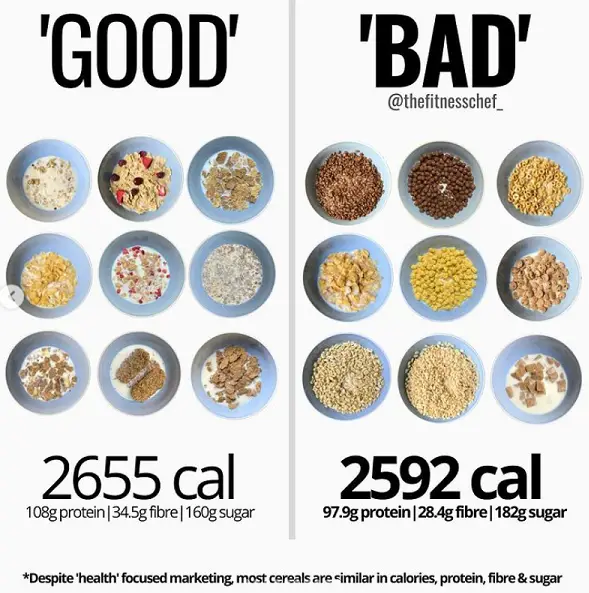
Cereal brands often market certain ones as healthier options than others. We’re convinced through pretty, “nature” packaging, names, and buzzwords that these cereals are superior to other traditional cereals. In reality, these “good” cereals often have roughly similar nutrition profiles – sugar, calories, fat, fiber, and all. If this food chart is saying one thing, it’s to check your labels not just for healthy nutrient-packed ingredients, but the nutrition panel too.
Read: YouTuber Explores How Much Food the Human Stomach Can Hold
15. Fitness Culture
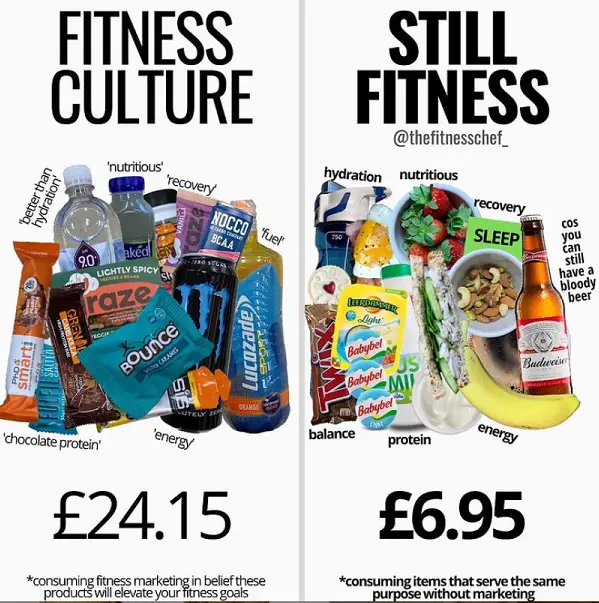
Much of the fitness industry is built off of making you believe that you are somehow not good enough the way you are. If you just follow this program, buy this membership, consume these products – then you will finally be “worthy”. My question is, worthy of what? The last time I checked, our bodies didn’t define our value as human beings. If you genuinely enjoy the expensive products marketed by the fitness industry then go for it. Understand, however, that these products will not get you any closer to your fitness goals than regular, everyday foods. Oh – and don’t forget to enjoy yourself occasionally, too.
16. What Do You Really Want?
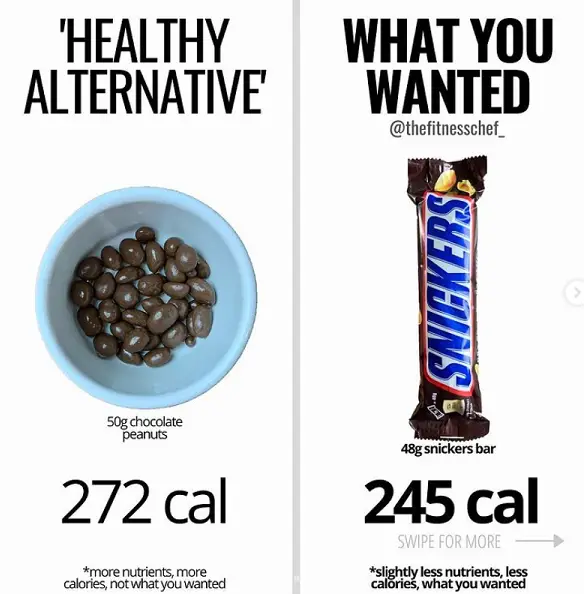
We’re all just trying our best to make healthy, informed decisions. While yes, chocolate-covered peanuts have slightly more nutrient value than a snickers bar, at the end of the day they are actually quite comparable. If you’re going to eat one or the other either way, then in this case go for the one you actually want. The “health” differences are negligible.
17. “High Protein”
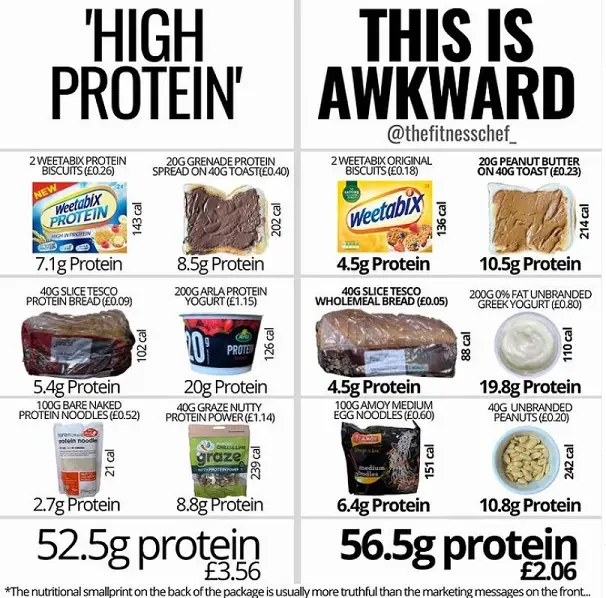
Food marketing strikes again! This food chart is another case of reading your labels and understanding food. In many cases, these foods are quite comparable if not a complete marketing gimmick. On top of that, you may be adding unwanted additional calories and more for a very small (if any) amount of extra protein. Just another reminder to do your research before buying.
18. It’s Not That Hard
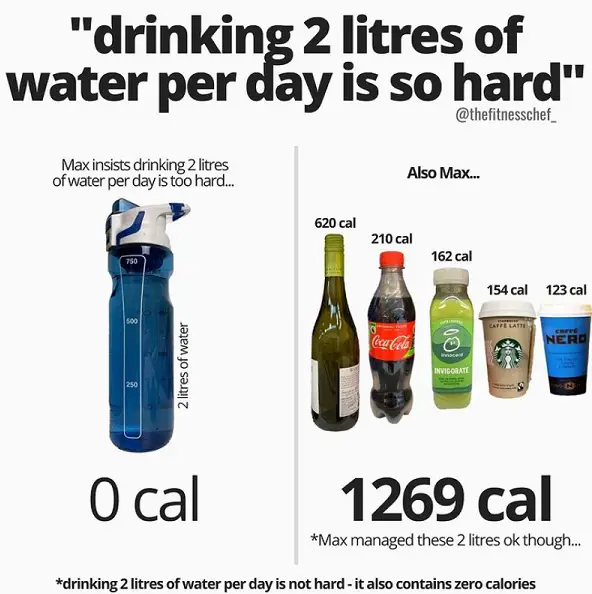
Drinking water is critical for your health and isn’t actually as hard as everyone makes it out to be. Take a bottle with you to work, set a reminder in your phone to drink water every 30 minutes, and wait and see what happens to your body. You will have more energy, your skin will look better, you’ll likely require less food, you’ll think clearer, and your mood will be better. There isn’t a single area of your health, mind, and body that drinking appropriate amounts of water won’t improve.
19. The Keto Diet Trend
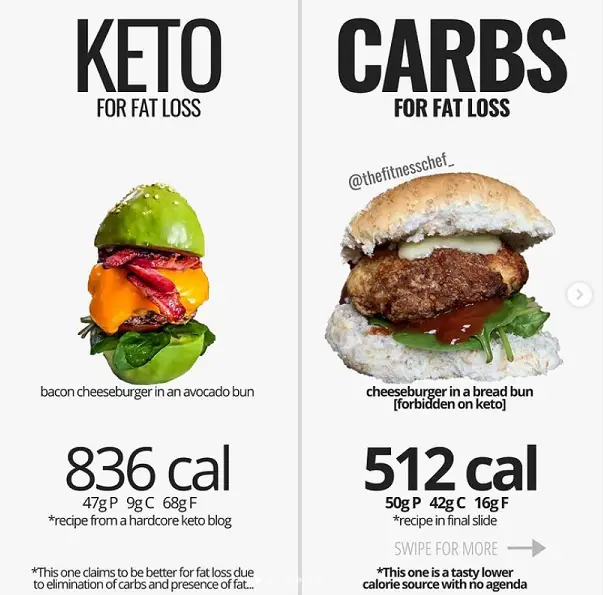
Fad diets are given the term “fad” for a reason: They are temporary trends that don’t actually work for the majority of people and eventually fade away. Keto is one of them. To be honest, any diet that promotes eating bacon over blueberries or chickpeas should probably raise some red flags. While keto has its uses in a clinical setting (i.e. epilepsy), and can be done healthily, it may not be the best choice for the average person. This is particularly true for obtaining healthy long-term, sustainable, and practical eating patterns.
“You burn more fat when in ketosis. But this is merely the extra dietary fat you are consuming, not body fat – which, according to countless systemic reviews, is entirely governed by total calories in vs. out.”
Read: How To Freeze Avocados So That You Always Have Fresh On Hand
20. Volume vs. Density
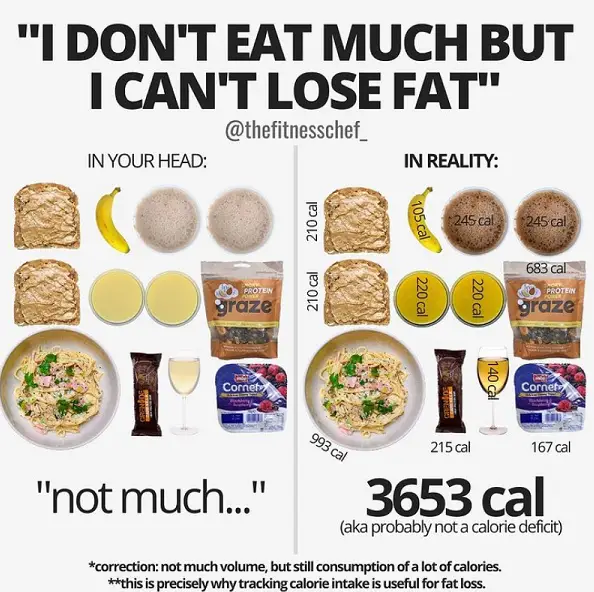
Many people don’t think they eat that much simply because the volume that they consume isn’t that high. While this may be true, the caloric density of the foods they are eating needs to be taken into consideration. Before you throw your hands up in the air perplexed, take a real, honest look at what you are consuming each day. Likely it’s more than you think. Not to mention, that most people do not accurately recall how much they eat (hint: it’s usually more than the think).
21. Protein Vs. Marketing
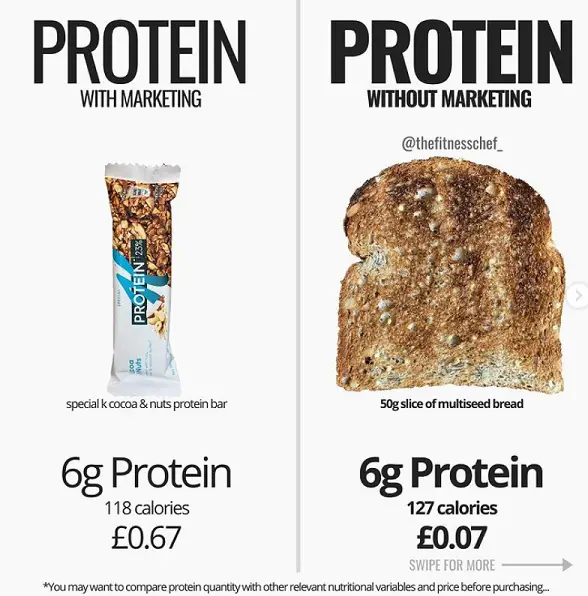
Before you go spending money on expensive products marketed as “high protein”, have a look at the regular grocery store items. Things like bread, skim milk, regular peanuts and cereals often have just as much protein as these “special” products. On top of that, they often contain less sugar and other additives. Don’t believe us? Take a look at this food chart above.
22. Carbs Don’t Make You Fat
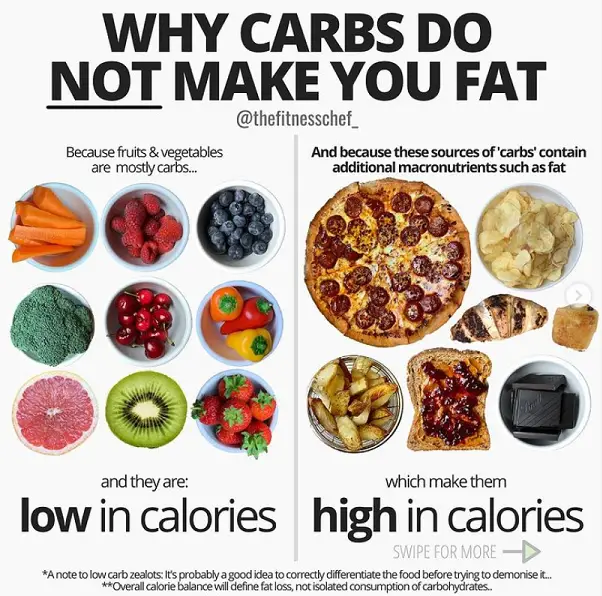
The latest trend in the wellness industry is that carbs are making you fat and you should cut them out of your diet. This is entirely misleading information. Carbs themselves do not make you fat. Consuming too many carbs that are also high in sugar and fat does. Everything in moderation, while keeping a large part of your diet fruits and vegetables, will go a long way.
23. Calories Actually Are Equal
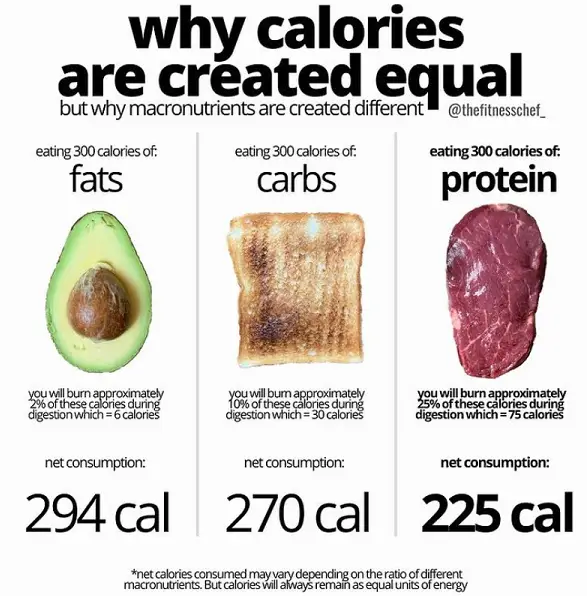
Calories are all the same – it’s the macronutrients that they come in that are different!
“When people claim “calories are not created equal”, what they hopefully mean is that macronutrients are metabolized differently. Because a calorie will always be equal in that it is a unit of energy, regardless of the source.“
24. What Really Is “Good” And “Bad”?
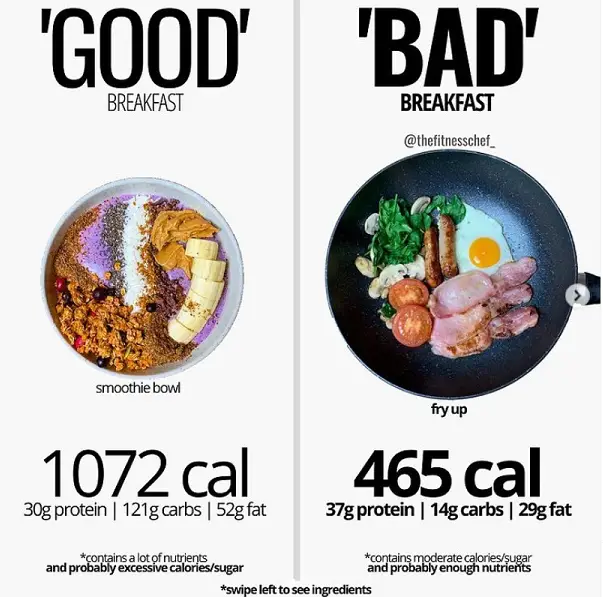
Yes, the smoothie bowl on the left contains a lot of nutrients. Unfortunately, it also is really high in calories and sugar. The plate on the right, however, which people will say is less healthy, still contains plenty of nutrients and less than half the calories and sugar of the smoothie bowl. It contains 3 bacon rashers, reduced-fat sausage, an egg, a whole tomato, mushrooms, and spinach. The smoothie bowl has acai powder, blueberries, two bananas, peanut butter, greek yogurt, granola, coconut, cacao nibs, linseed, flaxseed, and chia seed. Again, plenty of nutrition there, but likely more calories than you need.
Read: Handy Chart Shows You How Long You Can Freeze Different Foods
25. How To Enjoy Fast Food
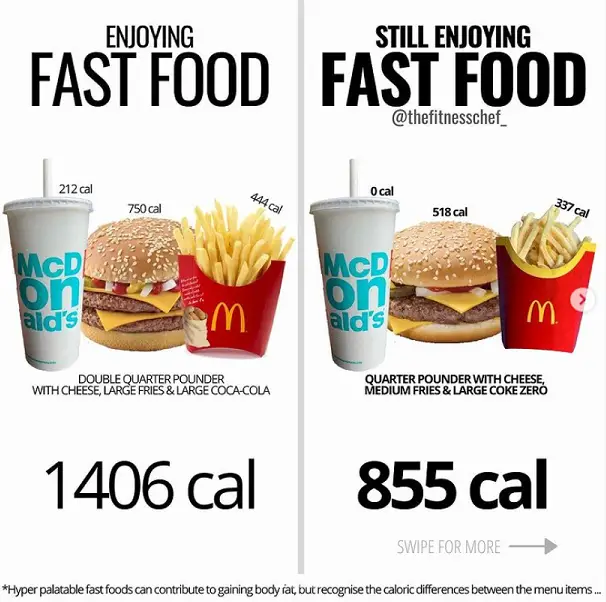
Should you eat fast food all the time? Of course not. Can you still enjoy it every once in a while? Yes! What’s better, there are ways to enjoy it without completely going overboard. You’ll likely feel better (or at least less so) after consuming a slightly less heavy version of your go-to fast food meal, too. I don’t know about you but this just improves the overall experience in the end.
26. Sugar Does Not Make You Fat
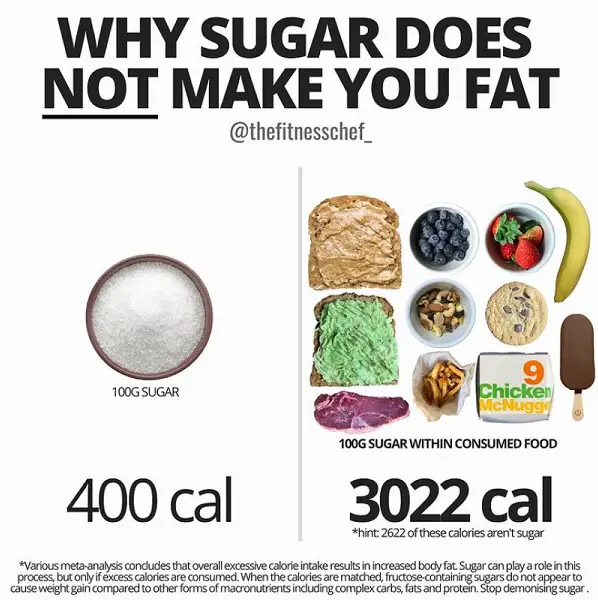
Sugar alone doesn’t make you fat. Excessive calorie intake does. Now, often foods high in sugar are also high in calories (from fat and protein too), which definitely will help you pack on the pounds. Context matters, you shouldn’t eat high sugar processed food all the time, but it’s not those occasional servings that lead to weight gain, it’s calories.
“Sugar is a carbohydrate. It contains 4 calories per gram, does not contain any nutrients, fibre or satiating qualities. Whilst lack of satiety may subjectively lead to excessive consumption of more calories, the same presumption can be argued for any food source.“
27. Calorie Defecit = Weight Loss
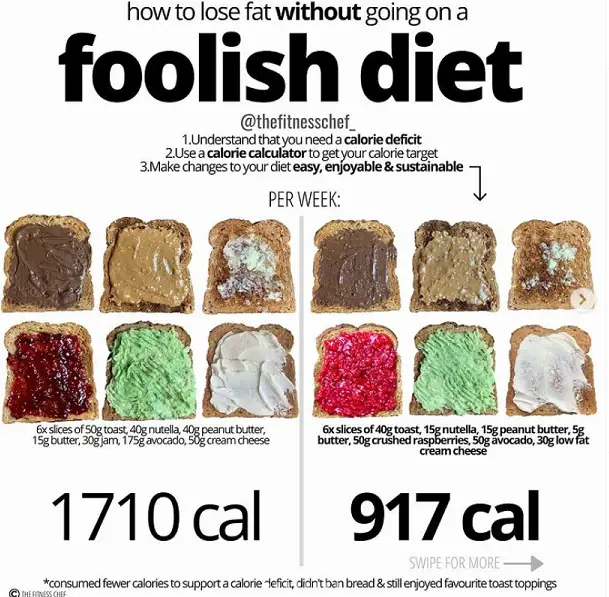
Small, simple changes to your daily habits will lead to a calorie deficit which will lead to weight loss. This means portion control, swapping a few of your weekly mochas for a lower-calorie option, and finding other alternatives that will allow you to enjoy life and your food and still lose weight. It’s all about understanding how much you are consuming and making sure it is helping you to reach your goals. It also means that you can allow room for the occasional splurge. The food chart above visualizes these changes perfectly.
28. Why Diet Culture Doesn’t Make Sense
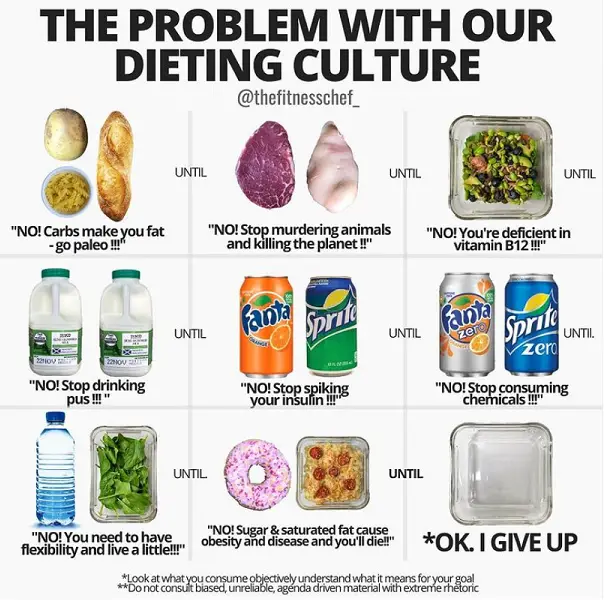
Everything we read, see, and are told by the health, fitness, and “wellness” industry is a contradiction. We are bombarded by “advice” from everyone under the sun – from doctors to personal trainers to random health and fitness bloggers. We’re told to avoid this, eliminate that, stop eating this, and nearly all of that information is not based on truth, or at least the whole truth. Rather than basing what you eat on what someone else says, focus on you, your goals, what you like and dislike, and what feels good for your body.
29. You Are Allowed To Enjoy Life
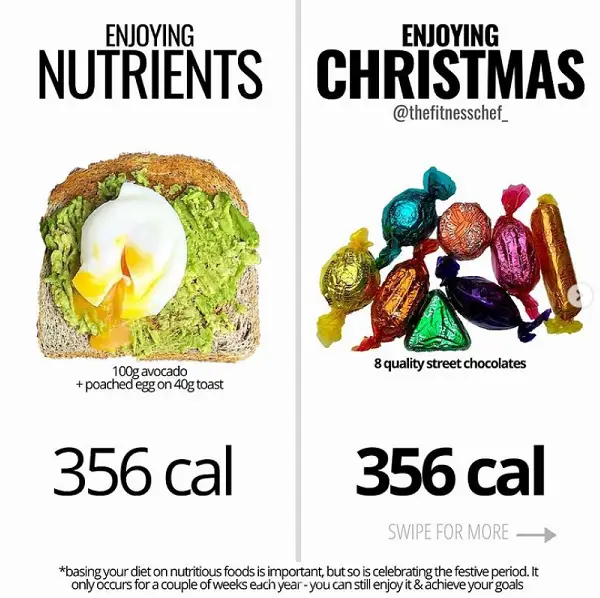
The fitness industry, especially around the holidays, will often attempt to guilt you into what you are and aren’t doing and eating. While they may frame it as “motivation”, let’s just call it what it usually is: Shaming. Here’s the thing: You can enjoy healthy food and also enjoy the goodies that come along with various holidays and birthdays. There’s nothing wrong with you and you haven’t failed. Life is short, so make sure you enjoy it and make happy memories rather than stressing about healthy diet and exercise 24/7.
30. Stop Eyeballing Calories
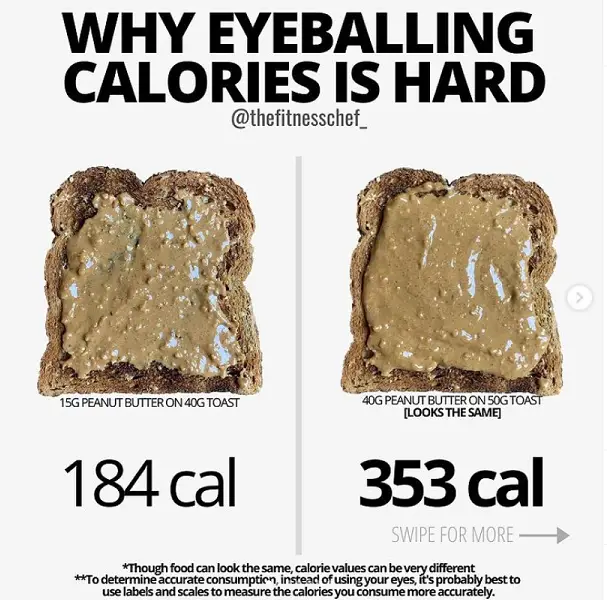
Do you need to be weighing and measure every bit of food you consume down to the gram in order to lose weight? No, of course not. You do, however, need to be mindful and honest with yourself while eating. If you have weight loss goals, then you need to make sure that you are actually consuming the appropriate amounts. Otherwise, your “tablespoon” of peanut butter will actually be two and a half, your “cup” of cereal will be closer to two, and you will be further away from your goals.
“The data shows us that people underreport their caloric intake by 30-50% & overreport activity by almost 50%”
– Layne Norton, PhD
Read: 15 People Share Their Favorite ‘Poverty Meal’ From Childhood That They Still Eat Today
30. Lower-Calorie Swaps
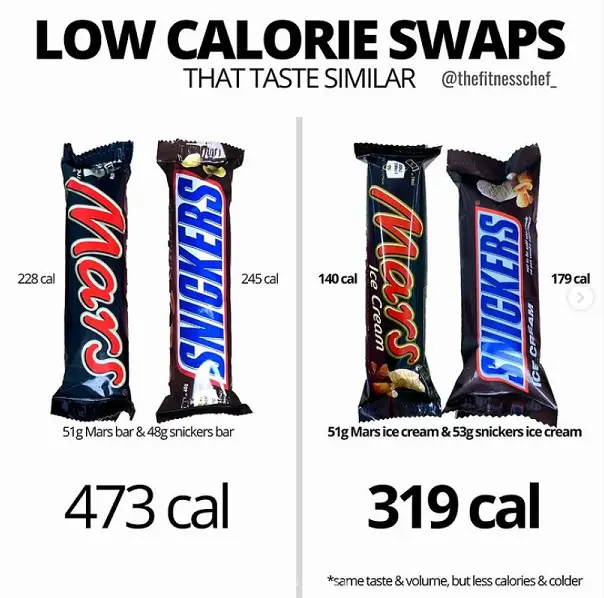
There are ways to still enjoy some of your favorite foods, snacks, and condiments without completely ruining your daily calorie intake. Switch to using leaner cuts of meat, lower-fat cheese, smaller portions of things like chocolate, and black coffee for a latte. These small switches allow you to still enjoy your favorite things without breaking the calorie bank to do so.
31. Don’t Feel Bad When You Eat A High-Calorie Food
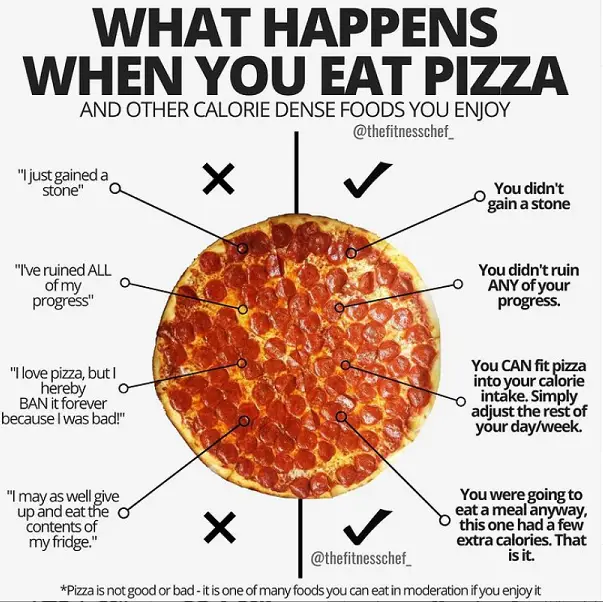
Just like losing weight requires consistency, so does gaining weight. Having something like pizza, or any other high-calorie food that you enjoy, on occasion doesn’t mean anything. No one food is going to make you fat and while certain foods might bloat you temporarily, you don’t gain weight with every bite.
“Stop beating yourself up when you consume the food you love. Understand what consumption of it means and adjust your overall diet to make it fit. Nutritional wellbeing is about finding a balance of calorie intake/output, acquiring sufficient nutrients, adherence and eating enjoyed foods to support your mental health. They should all come together to support your goal and make you happy each day.“
32. Dried Fruit Vs. Fresh Fruit
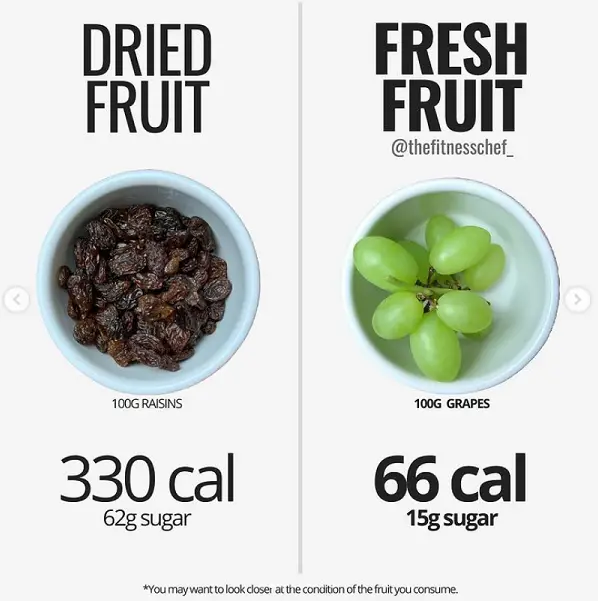
We think we’re making a healthy choice when we choose dried fruit over other treats. Unfortunately, dried fruits end up being quite a high-calorie, high sugar snack. You are better off eating the fresh fruit. With that, you get a higher satiety value for fewer calories and sugar.
33. The Little Things Matter
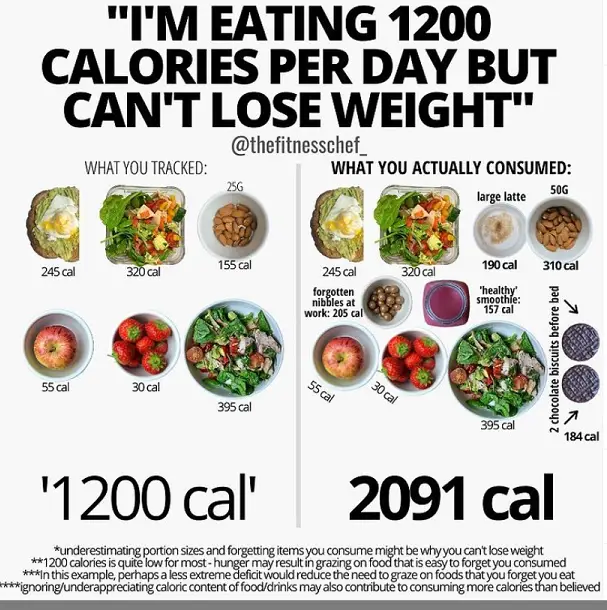
The little nibbles and drinks you have throughout your day count and they do add up. This is why you are likely eating more calories than you realize and therefore not losing weight. If you do find yourself in need of some snacking throughout your day, then you maybe want to reevaluate your daily calorie target. If it is too low and you are constantly hungry, you will end up snacking and having uncontrolled food consumption instead of conscious eating.
34. Stop Juicing
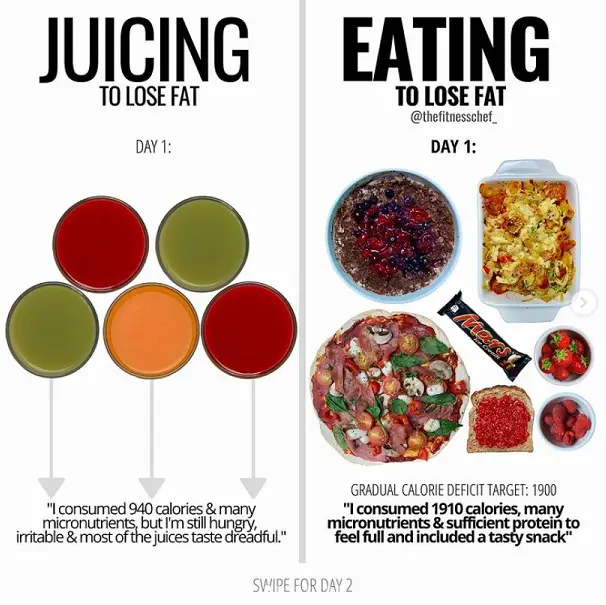
I don’t normally completely shut down any specific diet choice but the juice diet is one we should all leave definitively in the past. It is not good for your body and it does not work long-term. You sacrifice your health and happiness to lose weight but you don’t actually learn calorie control or portion sizing. You might lose weight in the short-term, but it will eventually you’ll gain it back and find yourself staring down the barrel of yet another juice “cleanse”, a term that is completely wrong, anyways.
“Such statements could not be more erroneous. Firstly because the human anatomy is literally designed to gather, chew and digest food as energy for locomotion. And secondly, because our working organs literally operate to detoxify our anatomy already.“
Read: What Food Product Came Out the Year You Were Born?
35. Clean Vs. Dirty
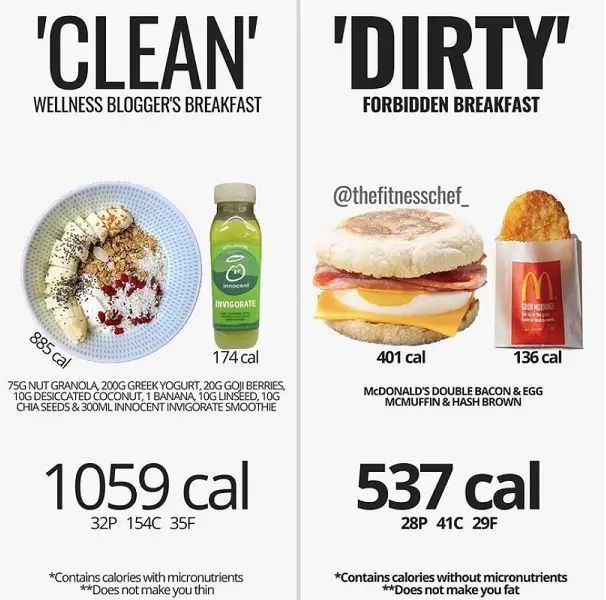
The words “clean” and “dirty” are just more words designed to make some foods saints while others are evil. The reality is, it isn’t that cut and dry. While yes, the breakfast on the left has plenty of micronutrients in it, it is also quite high in calories and sugar. The breakfast on the right contains few micronutrients, but also a lot fewer calories. Neither one of these meals will make you fat or thin. Despite this, the left will be praised and the right will be followed by learned remorse and shame.
36. Healthy Doesn’t Equal Weightloss
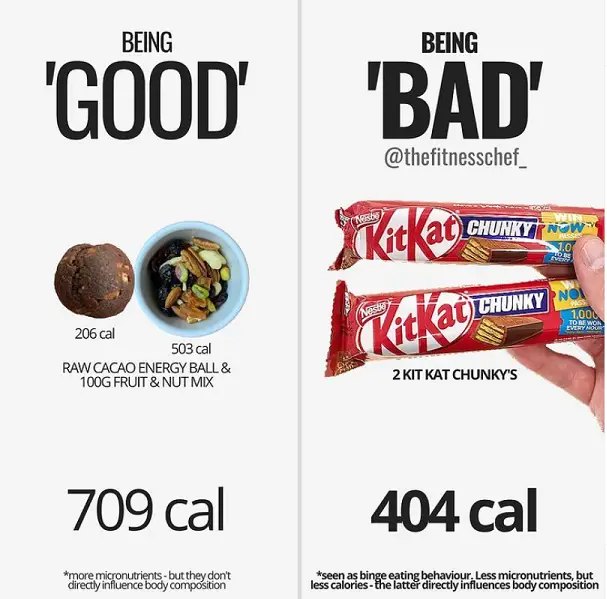
Healthy doesn’t equal weight loss just the way unhealthy doesn’t equal weight gain, take a look at the food chart above. At the end of the day, it’s all about knowing how many calories you’re consuming and staying at your goal. Of course, you want to eat healthy most of the time (healthy meaning high micronutrient value). If occasionally, however, you realize you’ve got room left in your daily intake and want to have a treat that fits within that space – go for it! Surprise of the century: You can include things like chocolates and sweets into your diet and still lose or maintain your weight.
37. 500 Calories
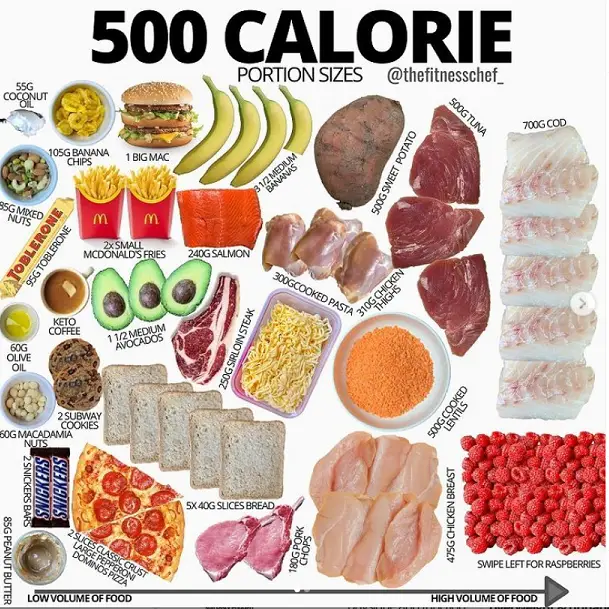
Do you know what 500 calories looks like? Well, this photo will show you. If you’re really hungry and want to eat enough to fill your tummy without going overboard calorically, look to some of the higher-volume foods. If you’ve got 500 calories to spare in your day and you want to treat yourself a bit, look at some of the lower-volume foods. In order to reach your goals, it’s all about understanding what you are consuming.
38. Eat To Support Your Mental Health, Too
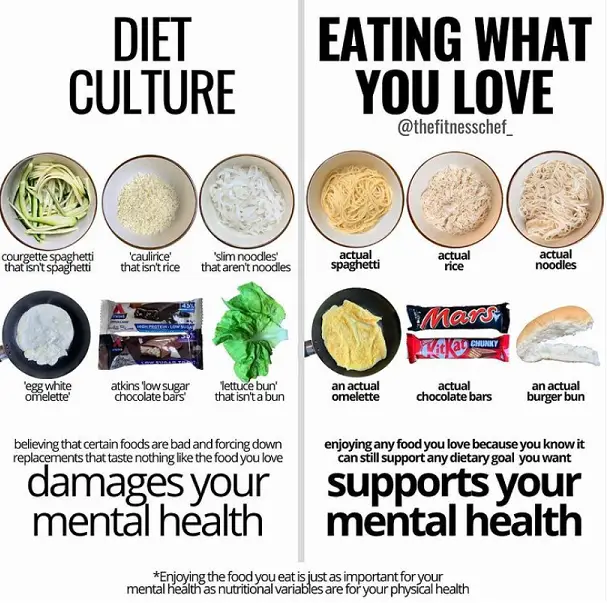
Diet culture is highly damaging to many people’s mental health. It creates unhealthy relationships with perfectly acceptable foods and creates shame around consuming them. It takes away the enjoyment of life and food and can be the crux of disordered eating and eating disorders.
“Mental health is defined by a number variables – happiness being one. Eating what you love is not only important when attempting to adhere to a nutritionally varied, flexible and supportive diet, but it is also indispensable to our long term happiness.“
39. Don’t Be Fooled By Marketing
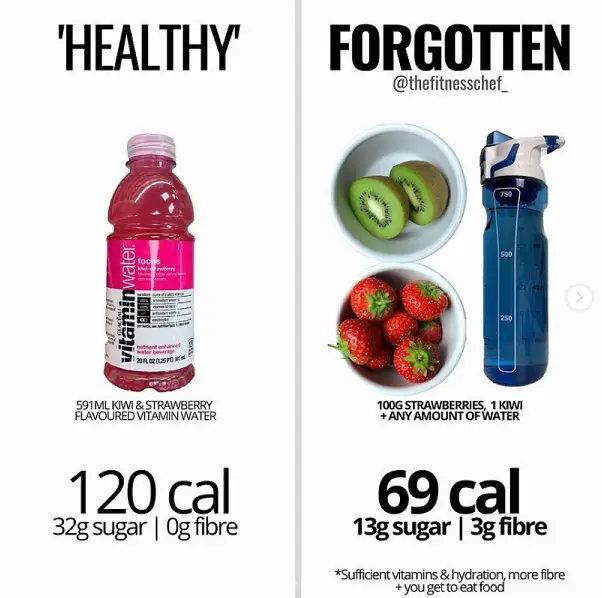
Marketing is effective and very clever. It’s so clever, in fact, that it can make us almost entirely forget about the real foods that these packaged “healthy” goods are based on. Especially when it comes to drinks like this that use words like “innocent”, “vitamin”, or “naked”. It makes us forget that we can get a lot more (or, a lot less, depending on how you look at it) out of the real foods. In fact, “eat real food” is probably the best nutrition advice you can get. Just like this food chart above, look beyond the advertising.
40. Find Compromise
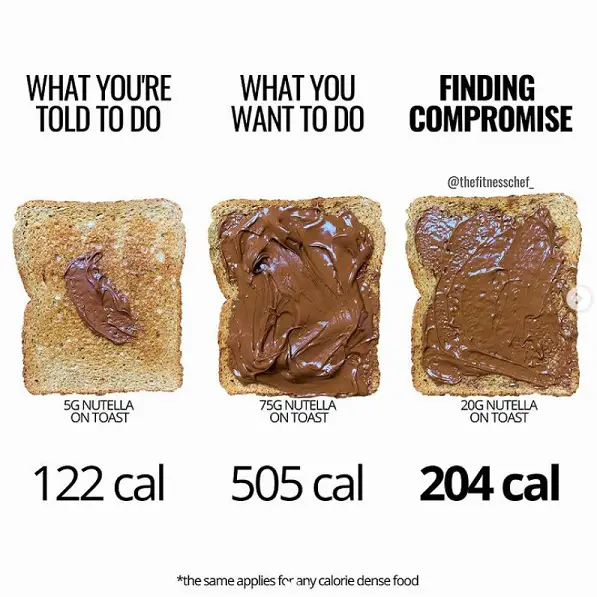
If these food charts have said anything, it’s that if you deprive yourself of your favorite foods, you will eventually eat your desired portion of that food. The longer you deprive yourself, the larger amount of that food you will likely eat. So instead, find a compromise: One that satisfies your craving but doesn’t go overboard.
“Limitation, exclusion and extreme conservatism are things you are told you need to do in order to improve your diet. Whilst this is true for fat loss in that decreased calorie consumption = more fat loss, when it comes to foods you adore, extreme restriction can be difficult. You’re told you cannot eat a certain food, but you enjoy it. You’re told you can only eat minuscule portions, but you want more.“
At the end of the day, we all need to eat food to live. Ideally, the foods we eat have a lot of nutrient value for our bodies. That being said, life is for the living, and part of living is enjoying cake on your birthday, toasting a big accomplishment with champagne, and allowing yourself a cookie on a Tuesday because you made it through the day and you feel like it. As long as you are aware of what, how much, and how often you are consuming certain foods, everything can fit into a healthy diet. That’s right: You can look good, feel great, and actually enjoy life, too. Don’t let anyone trick or shame you into thinking otherwise.
Keep Reading: 28 American Foods That Are Banned In Other Countries
